How to Teach Kids to Read in Spanish: A Guide for Parents
Inside: An introduction to teach your kids to read in Spanish.
One common question I see over and over is this: how do I teach my kids to read in Spanish? If we’re homeschooling bilingually, should we teach literacy first in English or Spanish – or simultaneously? What resources are out these for homeschoolers in Spanish?
The right answer depends a lot on your situation and the unique mix of languages in your home. In our case, our kids learned to read first in Spanish, at their Spanish-only school. They both began at age 5. Later, when their reading skills in Spanish were solid, I began teaching some phonics in English at home (at age 6 or 7), and have used leveled readers in English as well.
My son is now well into chapter books in both languages. I tried to introduce English reading lessons right at 6 with him, and it didn’t go very well. So I backed off, and tried again in six months. It was a much smoother process and he was definitely more eager the second time around.
With that in mind, I encourage you to do a mix of research for teaching reading, along with closely observing your kids for signs of readiness and interest.
Now, what I shared above was me teaching my kids to read in English. But you’re here for tips on learning to read in Spanish! In preparins post, I consulted with my kids’ teacher and tutor. She has Montessori training and has worked with inicial – ages 3-5 in different settings. Since we’re doing distance learning this year, I’ve gotten a closer look at how my kids have been learning to read and write in Spanish and want to share those insights with you.
I’ll give quick overview of literacy in Spanish vs English, what sequence of letters to follow, and ideas for teaching both reading and writing for beginners.
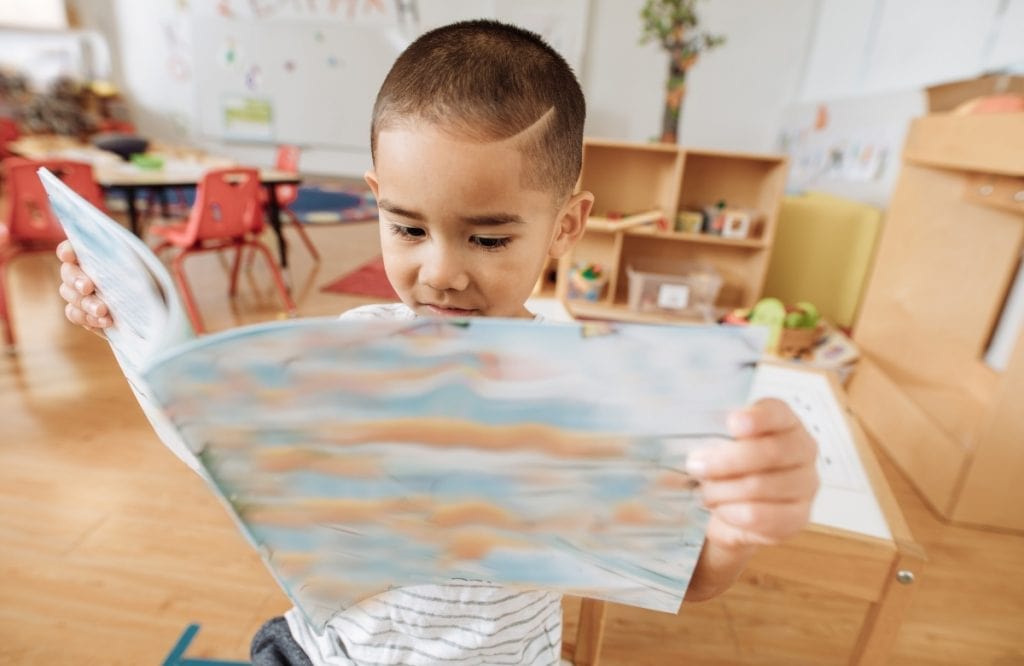
What is clear is this: any and all effort you put into your children’s growing literacy is beneficial, in any language!
“A new study has found that children who had strong early reading skills in their native Spanish language when they entered kindergarten experienced greater growth in their ability to read English from kindergarten through fourth grade.
Importantly, when the researchers factored in how well the students spoke English, it turned out that native language reading skills mattered more — even at kindergarten entry — to the students’ growth across time. Plainly stated: children who had stronger Spanish reading skills upon entering kindergarten did better across time, even than their Spanish-speaking peers who were more fluent in speaking English but less proficient in reading Spanish.“ – Science Daily
HOW TO TEACH KIDS TO READ IN SPANISH
This post outlines the process of learning to read in Spanish. Here’s what’s included, in case you would like to jump to a specific section:
- Differences Between English and Spanish
- Getting Ready to Read
- Teaching The Vowels in Spanish
- Introducing Consonants and Syllables in Spanish
- Resources for Teaching Reading in Spanish
DIFFERENCES BETWEEN SPANISH AND ENGLISH
Though Spanish and English have similar alphabets, the actual process of learning to read and write with those letters is fairly distinct.
Here’s an overview on the differences Spanish and English, from Texas Essential Knowledge and Skills for Spanish Language Arts and Reading and English as a Second Language Subchapter A. Elementary:
Spanish, as opposed to English, has a closer letter-sound relationship and clearly defined syllable boundaries. The syllable in Spanish is a more critical unit of phonological awareness than in English because of the consistent phoneme-grapheme correspondence. Syllables are important units for Spanish because of their strong effect in visual word recognition (Carreiras et al., 1993) and their major role in predicting Spanish reading success. In addition, Spanish presents a much higher level of orthographic transparency than English and does not rely on sight words for decoding. This orthographic transparency accelerates the decoding process, and the focus quickly moves to fluency and comprehension. However, in English sight words are used because of words that are not decodable such as “are” or “one.” In Spanish, decoding issues are not as prevalent as issues of comprehension. These specific features of the Spanish language will influence reading methodology and development.
In other words, Spanish graphemes (written letters) generally have one consistent phoneme (sound).
In English, both vowels and consonants have multiple sounds. Teachers have to spend a lot of time teaching decoding skills, as well as recognization of “sight words” that break the “rules.”
Learning about how individual sounds make up spoken words – phonemic awareness – is a cornerstone of beginning reading instruction in the United States. When teaching kids to read in English, it is standard practice to begin in kindergarten and early first grade by teaching them the sounds of the words independent of the letters: for example, “cat” consists of three sounds (k-aa-t). – Stanford News
In Spanish, however, the emphasis is on learning to form and read syllables. Once learners thoroughly know the vowel sounds, and can form syllables (la, le, li, lo, lu), they are well on their way to decoding most words.
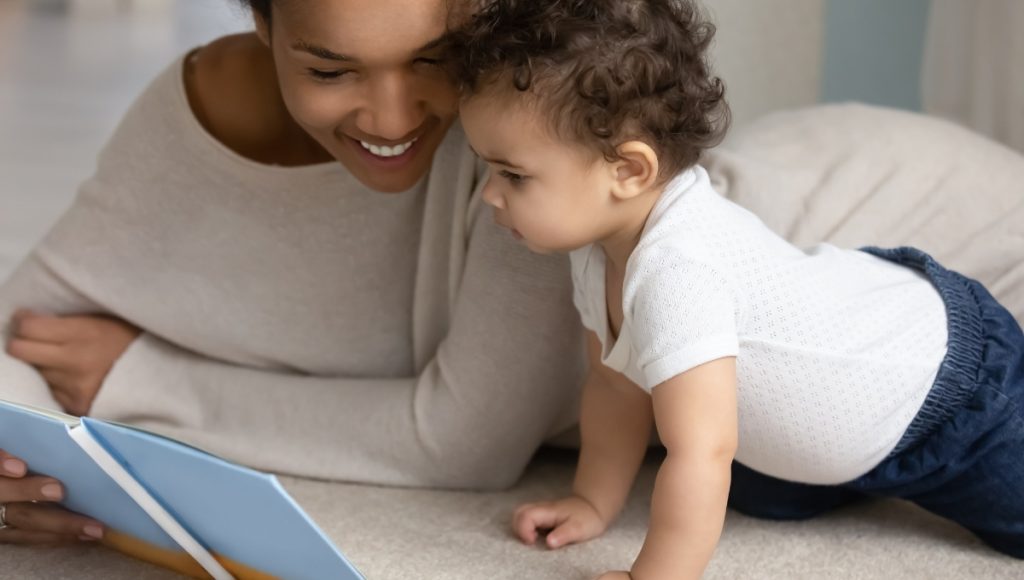
GETTING READY FOR READING AND WRITING IN SPANISH
Teaching your kids to read in any language really starts at birth. As you sing, say rhymes or fingerplays, and read board books to your baby, they are taking their first steps to literacy.
Reading aloud everyday is one of the most important things you can do. From this, children develop an instinctual love for books. They also develop notions like what direction the text moves in as the pages turn, and assimilate patterns of speech. It’s also important that your kids see you reading for pleasure as well!
According to Psychology Today, reading aloud to babies, toddlers, and kids have these effects:
Speedier processing allows babies and toddlers who recognize familiar words to pay closer attention to the next word in the sentence. Those kids get more out of each verbal experience, boosting vocabulary, and strengthening working memory, reasoning, and conceptual abilities.
… Furthermore, the rhythm, repetition, and rhyme of children’s books help lay down the neural networks kids need for reading.
So, when do you begin the formal process of learning to read?
This varies among experts and between children. Here’s a list of general milestones for things like starting the ABCs, writing their names, and reading simple words.
In my opinion, as long as you’re reading books together, there’s no rush to start formal lessons and I encourage a gentle approach to both reading and writing. (You can check out this quick article that advocates for not rushing kids into reading too early.)
For ages 3-5, here are some ideas for setting up the stage for learning to read in Spanish:
- Start teaching the alphabet as a song. Here are some ABC songs in Spanish. (There is not one main “ABC song” in Spanish like in English, so just pick your favorite!)
- Learn some rhyming poems together (Here are some well-known poems in Spanish. There’s also a great list of poetry books in Spanish in this post as well.)
- Post the ABCs in Spanish somewhere on your child’s eye level, in order. We posted them right by my daughter’s bed!
- You can buy some wooden letters or alphabet magnets to start with letter recognition.
- Play some verbal games like “what rhymes with ___?”
- Chat while reading books together. You can ask what they think will happen next, or ask about favorite parts of the story.
- Establish an awareness of syllables by practicing verbally (you can clap for each syllable — ma-má, pe-lo-ta).
Remember to read your child’s cues and keep it fun at this age!
STARTING WITH THE SPANISH VOWELS
When you are reading to being reading lessons in Spanish, start first with the vowels and teach them one by one. It’s really important to get a solid foundation in recognizing and writing the vowels before moving on to anything else. I recommend teaching letter formation as you introduce each vowel.
Some teachers introduce the concept of “strong” (a, o, u) and “weak” (i, e) vowels at this point as well, to prepare kids for what happens in vowel combinations later.
Recognizing the Vowels
Here are some ideas for learning to recognize the vowels:
- Use letter blocks or magnets and have the students search for “la vocal ‘a’,” for example. You could even put the letters in a dishpan of bubbles or bury them in in a sandbox to look for the right letters.
- Circle the vowel on a worksheet of hidden pictures or a mix of letters.
- Put a paper with pictures of different letters under a clear dish filled with rice or sand. Have the student “excavate” to brush away and find each letter, as shown below.
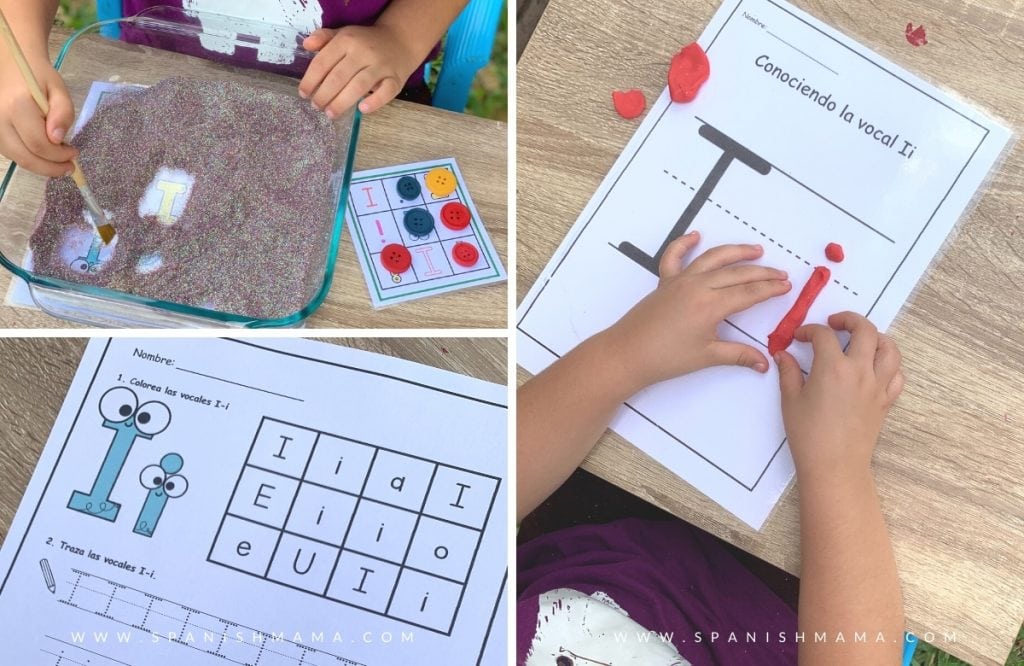
Writing the Vowels
As you work towards writing with a pencil (and this is when you want to start working on proper pencil grip), there are also many other sensory-friendly activities that kids can do as they learn letter formation. Most kids need these tactile experiences as they get started with reading and writing. Here are some fun ideas for writing the letters:
- Trace the letters with your fingers in sand or shaving cream, or use an outline of the letter cut out of sandpaper.
- Form the letter using playdough.
- Print a big outline of the vowel. The student can paint to fill it on, glue on something small like torn up pieces of paper, use stickers, or something related to the letter (“arroz” for “a”).
- Put the letter in a sheet protector and practice writing with a fat dry-erase marker.
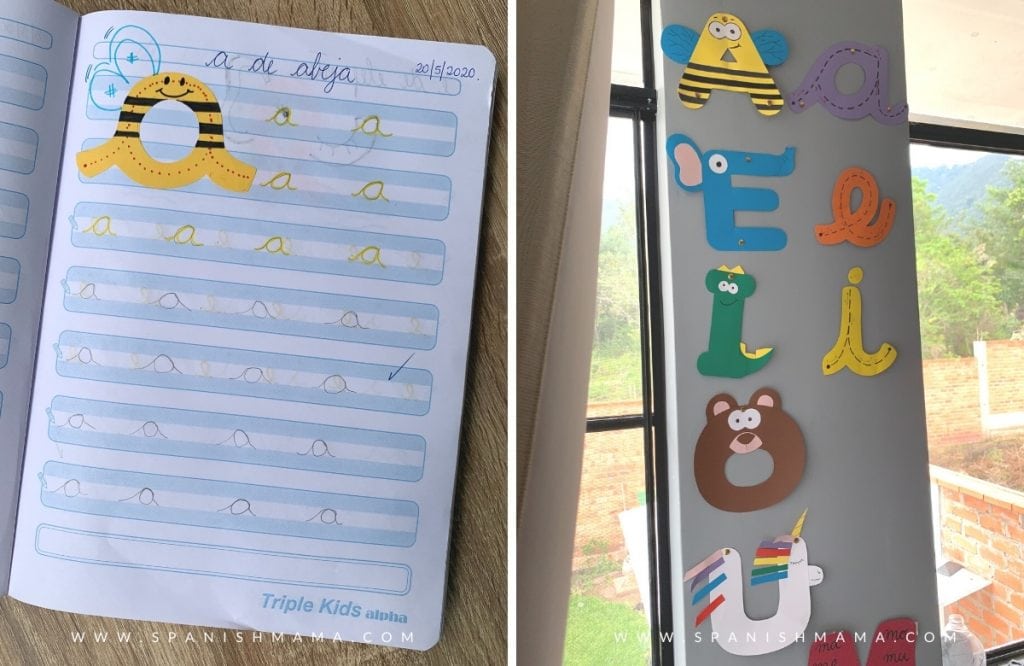
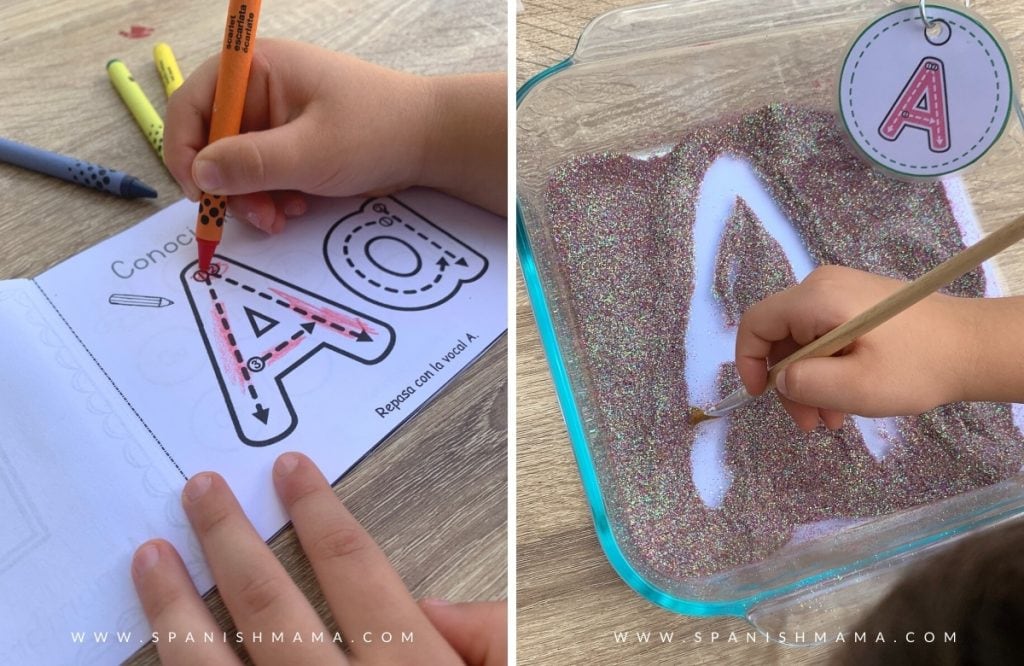
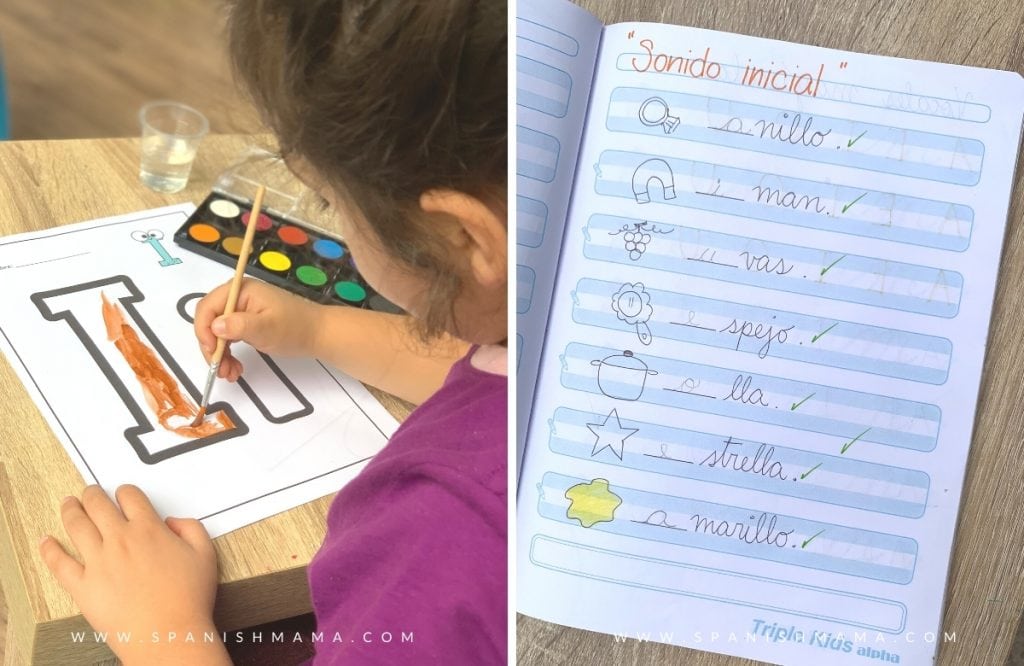
Learning the Vowel Sounds
Reading readiness also involved identifying the letter sounds, in different contexts. Some ideas:
- Search magazines for words that begin with a certain letter sound. Cut out the images and glue them onto an outline of the letter. (Drawing would work as well.)
- Look at pictures and identify which ones start with a certain letter.
- Choose a sound and list words that start with that letter.
- When ready, dictate the vowels and have the student listen to what you say and write it down. This can be done on paper, choosing a letter card, or writing in something like sand.
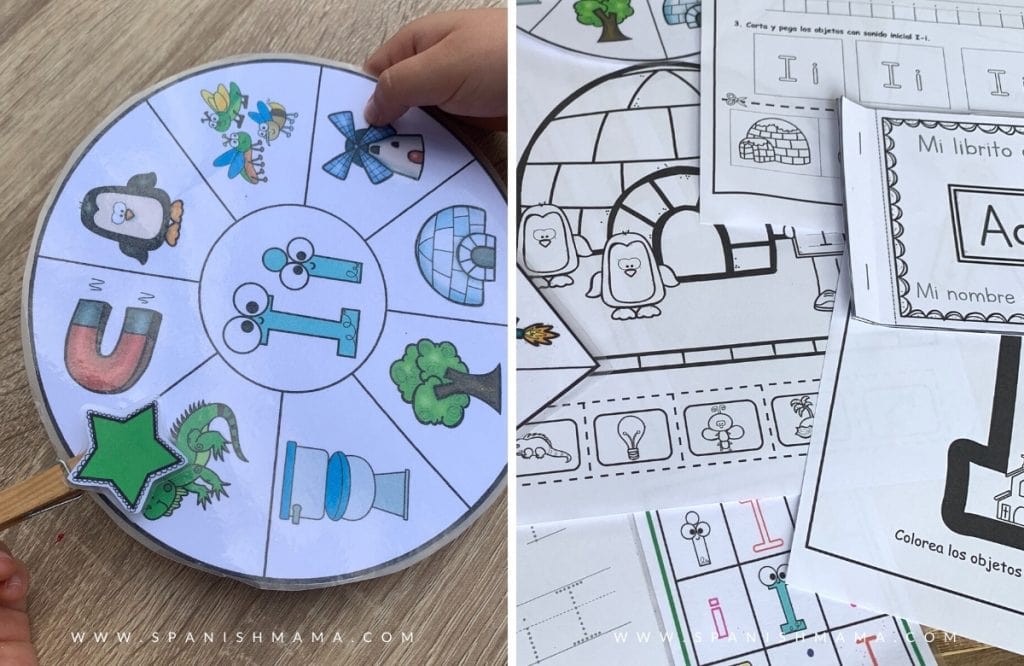
CONSONANTS AND SYLLABLES
Once kids are really strong with the vowels and can recognize them in a variety of contexts (and can identify them out of order too!), they are ready to move onto to syllables.
Most teachers start with either “m” – ma, me, mi, mo, mu, or “l” – la, le, li, lo, lu. First, you can teach the letter itself, and then being combining it with each vowel.
With these core consonant-vowel combinations, you can repeat similar activities to those suggested above. Practice writing, identifying sounds, and recognizing them in different contexts. Here are the syllable most teachers teach first:
- ma, me, mi, mo, mu
- la, le, li, lo, lu
- pa, pe, pi, po, pu
- sa, se, si, so, su
- da, de, di, do, du
- ta, te, ti, to, tu
- ra, re, ri, ro, ru (use this time to work on pronunciation)
Once students can write and identify syllables, they can begin to form and read simple words: mamá, loma, mima, el, la, etc. With just a few words, they can also read or write sentences: Mi mamá me mima. At this point, too, you can begin “dictations,” simply saying a word out loud and having the students listen and write what they hear. (Again, take all the time you need to teach these!)
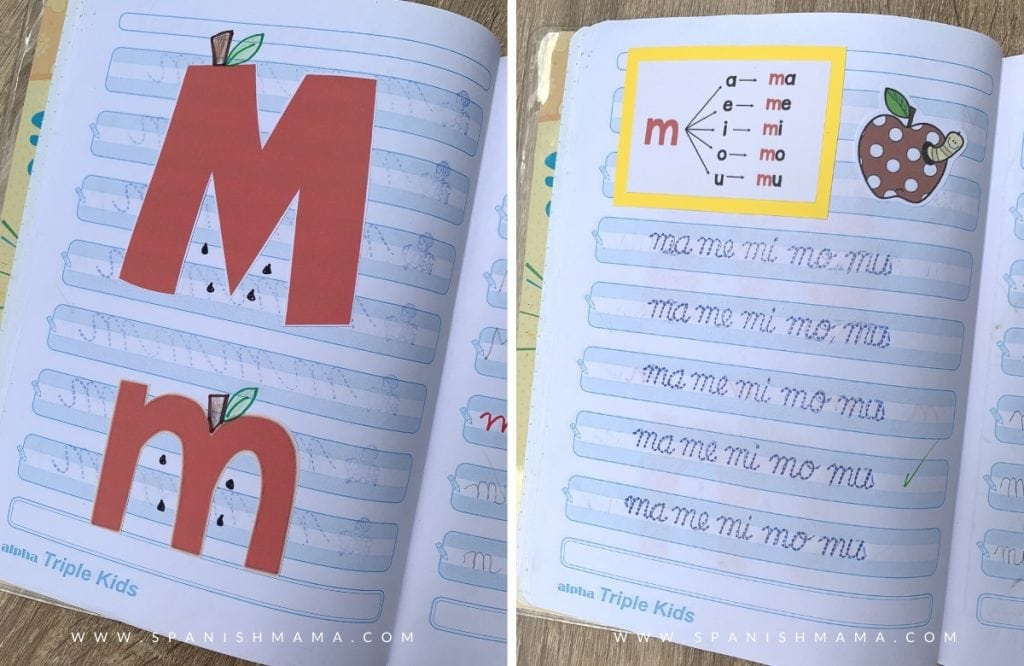
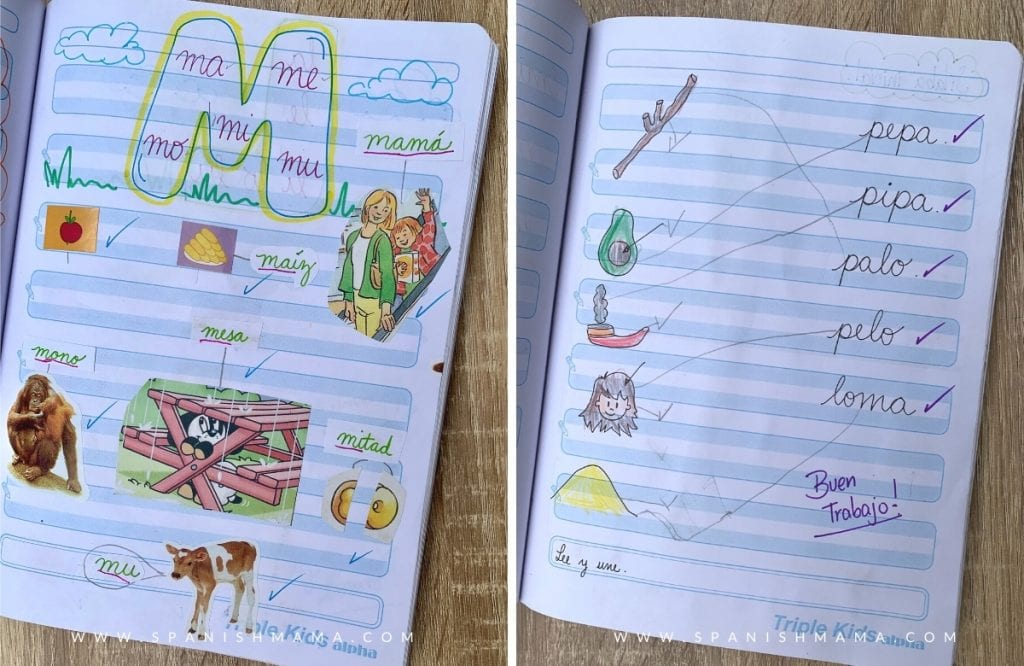
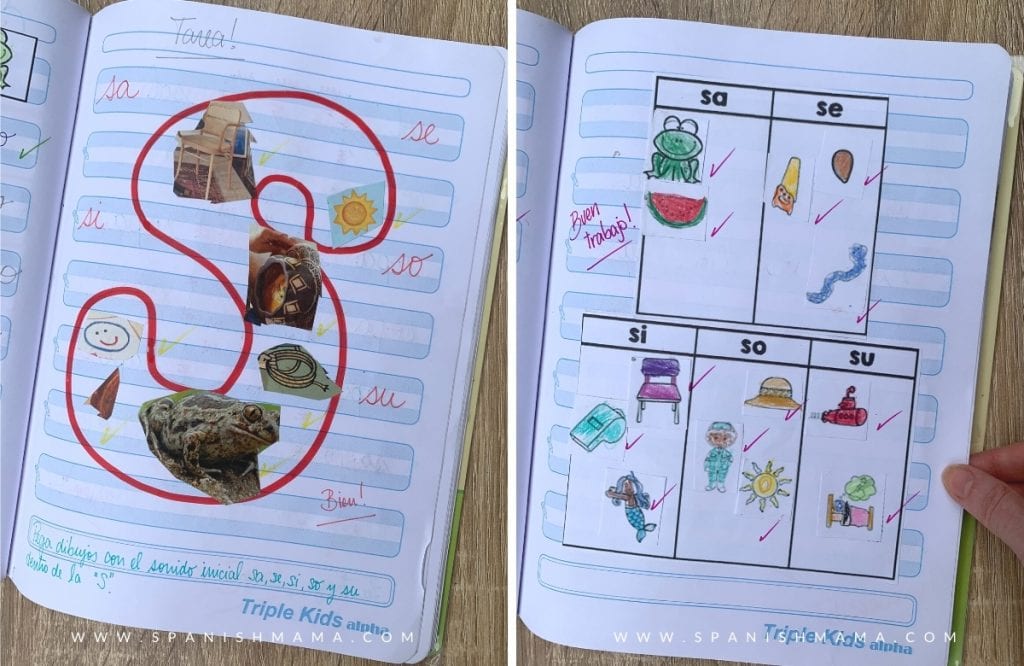
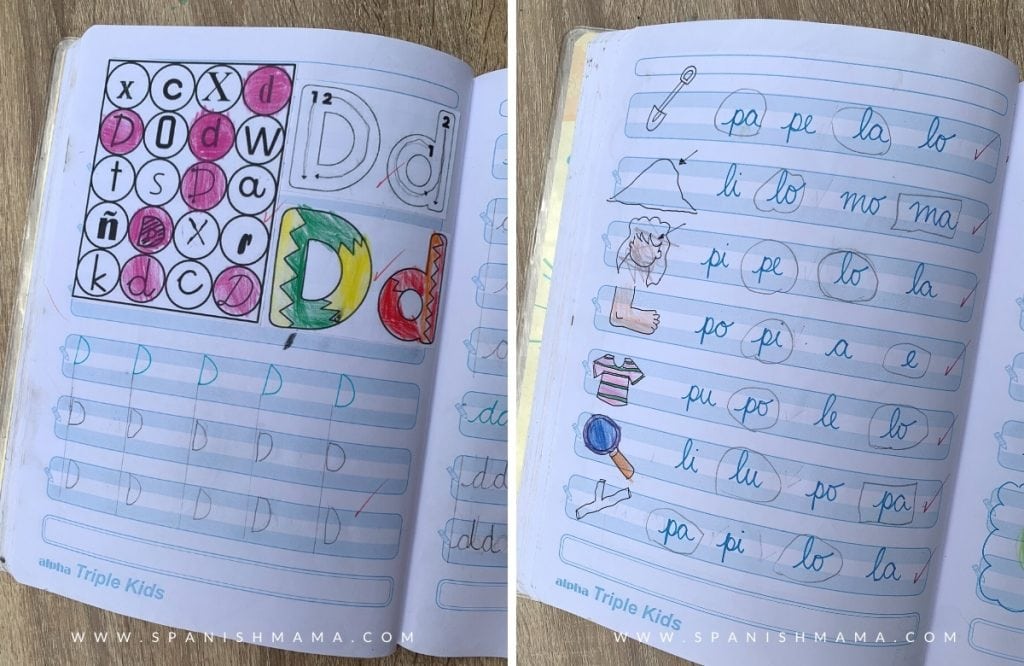
It’s helpful to print and laminate a set of syllable cards (and vowel cards), to manipulate different combinations together. You can play games like memory, practice reading the cards, or dictate a word and the students can find the right cards to form the word.
Here’s an example of the order many books use for the rest of the syllables:
Sílabas directas
- ña, ñe, ñi, ño, ñu
- ba, be, bi, bo, bu
- ca, co, cu (then teach ce, ci with soft sounds)
- va, ve, vi, vo, vu
- ga, go, gu (then teach ge, gi with the soft sound)
- ya, ye, yi, yo, yu
- ha, he, hi, ho, hu
- ja, je, ji, jo, ju
- za, ze, zi, zo, zu
- fa, fe, fi, fo, fu
- gui, gue
- lla, lle, lli, llo, llu
- ka, ke, ki, ko, ku
- cha, che, chi, cho, chu
- que, qui
- xa, xe, xi, xo, xu
- rra, rre, rri, rro, rru
Sílabas trabadas
- pla, ple, pli, plo, plu
- cla, cle, cli, clo, clu
- bla, ble, bli, blo, blu
- gla, gle, gli, glo, glu
- fla, fle, fli, flo, flu
- pra, pre, pri, pro, pru
- tra, tre, tri, tro, tru
- gra, gre, gri, gro, gru
- dra, dre, dri, dro, dru
- cra, cre, cri, cro, cru
- bra, bre, bri, bro, bru
- fra, fre, fri, fro, fru
You may decide to teach vowels-consonants as well. For example, you might teach “os,” to prepare for words like “mosca” or “bosque,” in which three letters in a row are presented:
- as, es, os, is, us
- an, en, on, in, un
- ar, er, or, ir, ur
- al, el, il, ol, ul
- az, ez, iz, oz, uz
- am, em, im, om, um
- ay, ey, oy, uy
- ac, ec, ic, oc, uc
RESOURCES FOR TEACHING KIDS TO READ
If you want to buy the fun printable in the pictures above, you can grab them from TpT!
Another resource is the Coquito series or Nacho series, which are popular textbooks that are used in Latin America:Lectura Inicial

Coquito Clásico 2020, lectura inicial (Spanish Edition)$12.95 (190)

ABC de Coquito: Lectura Inicial (Spanish Edition)$2.99 (2)

Coquito de Oro Integrado 2020, lectura inicial, escritura y tall…$18.45 (96)

Nacho: Libro Inicial de Lectura (Coleccion Nacho) (Spanis…$15.50 (561)Ads by Amazon
Mexico has also published their archived textbooks online, and you can find free books starting at first grade here, another free textbook here, and a free reader here.
This is a free printable workbook for beginners, and you can find another one here. You can find If you are okay with apps, these are helpful for practicing:
- ABC Mágico – ABECEDARIO
- Aprender a Leer – Silabario
- Escribir con las Sílabas
- Lee Paso a Paso
- Aprender a Leer con Grin
- Spanish Crossword Puzzles for Kids Lite
- Leo Crosswords
SPANISH READERS FOR KIDS
Once kids are able to read all the syllables and combinations of letters, they need to have lots of books on hand to read! Here are some sources for finding them:
- Pay for a subscription at Reading A-Z (they have a large collection of leveled readers)
- Download a collection of 60 beginning reader texts here.
- Find readers through Scholastic
Spanish Readers

Rafi y Rosi Piratas! (Spanish Edition) (Rafi and Rosi)$9.95 (1)

English-Spanish First Little Readers: Guided Readin…$19.53 (29)

Hay un Hombre Mosca en mi sopa (There’s a Fly Guy In M…$4.99 (44)

English-Spanish First Little Readers: Guided Readin…$20.99 (9)
VIDEOS SHOWING HOW TO TEACH KIDS TO READ IN SPANISH
Here are some videos below to help you explore a bit more and see more ways for kids to begin learning to read in Spanish
Do you have more ideas on how to teach kids to read in Spanish? Let us know in your comments below!
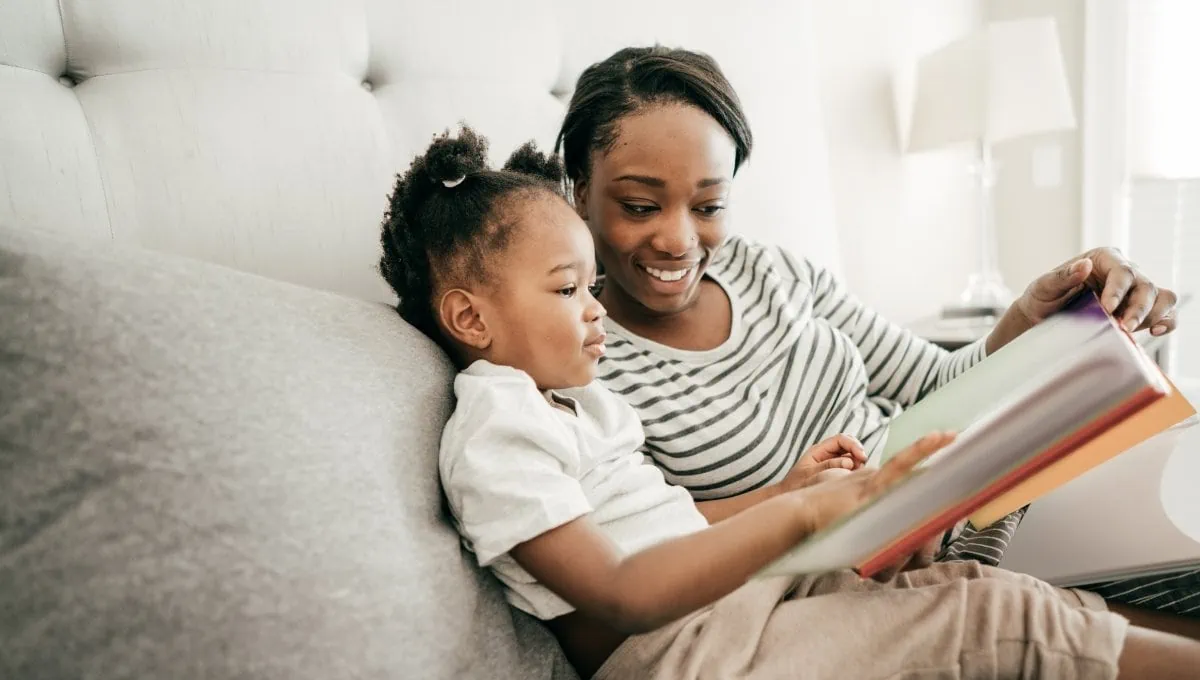
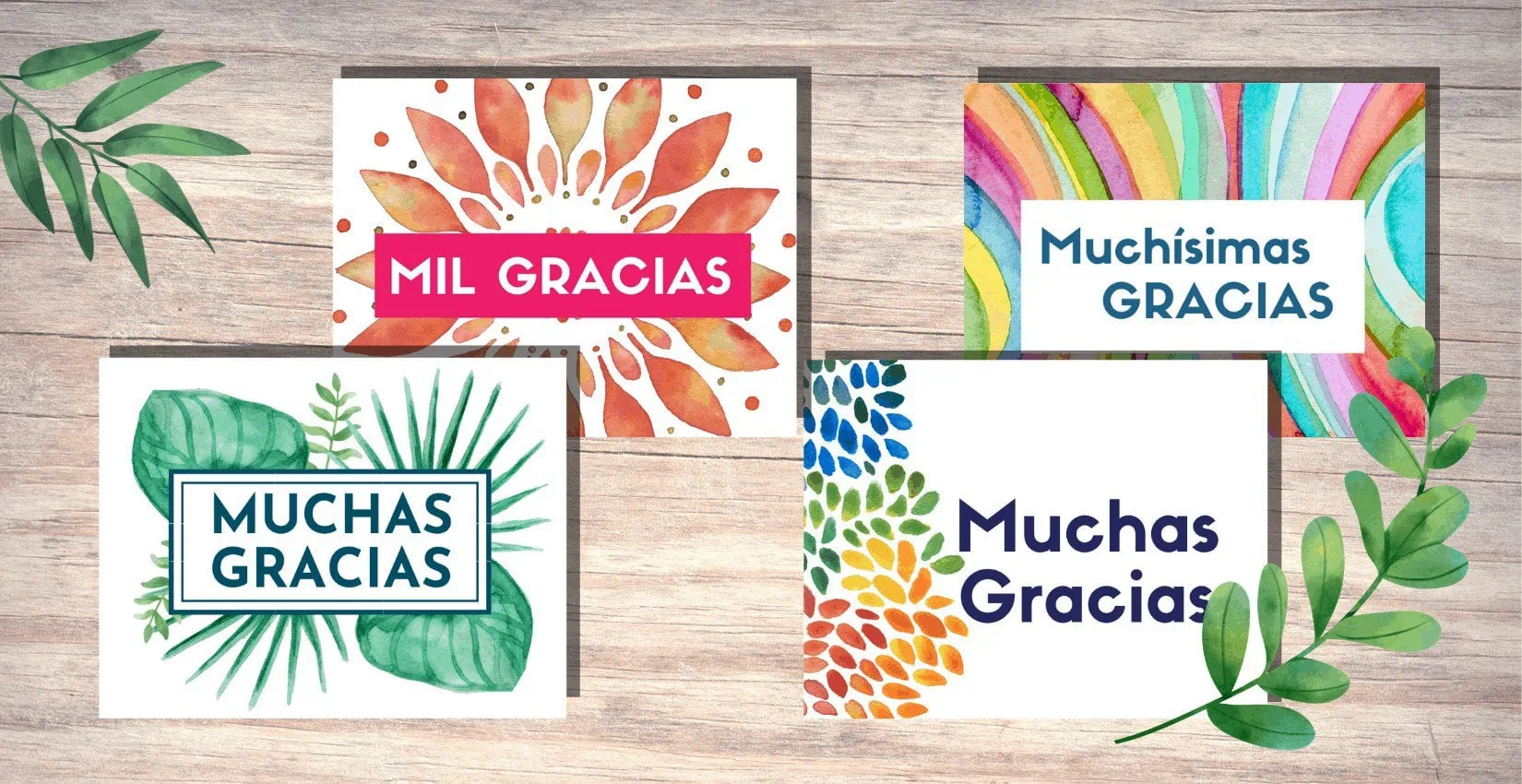
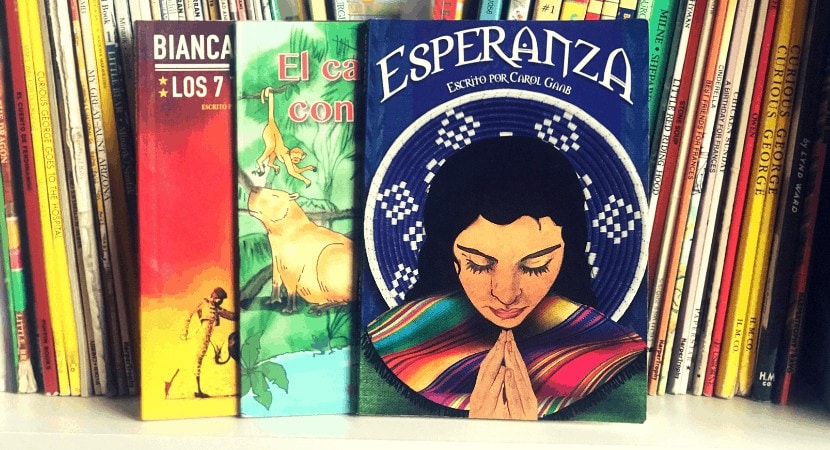

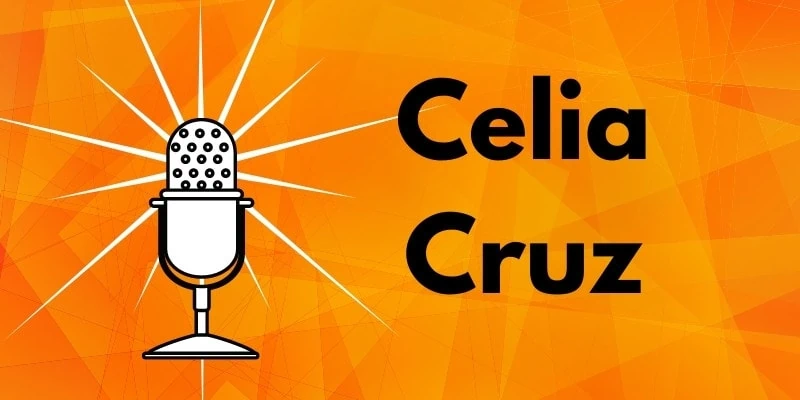
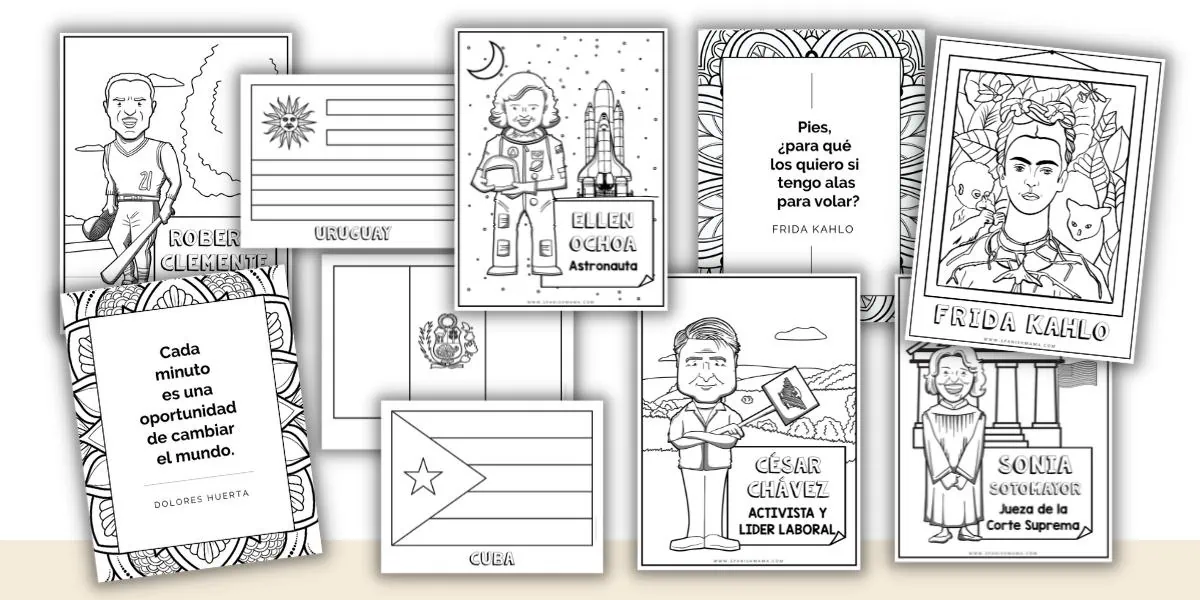

¡Muchas gracias! I want to teach my four-year old to read in Spanish this year, and this post was everything I needed and more! First off it was such an encouragement! I felt like my “Mom instincts” were telling me that it would be best to teach him to read in Spanish first since it is soooo much easier! And that I should start with the vowels. This confirms both those things and has given me a lot of ideas and resources to check out.